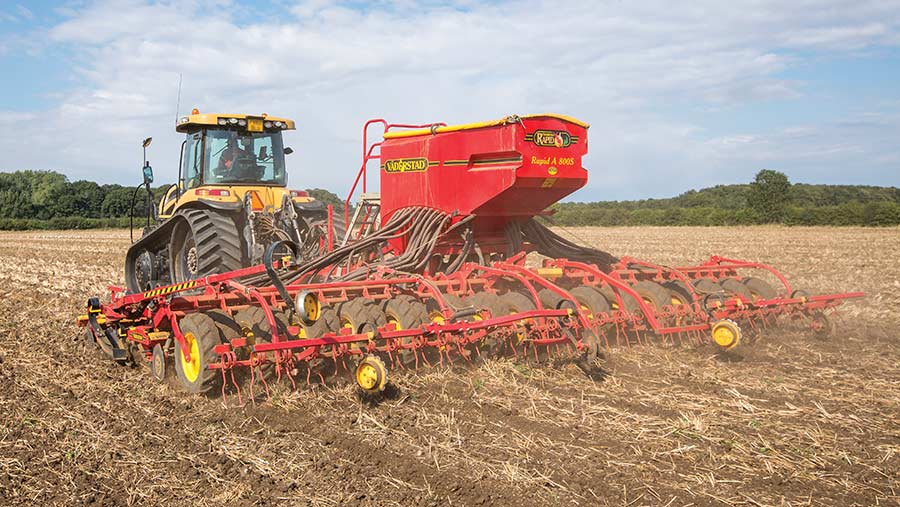Survey gives pointers on how to successfully grow OSR
 © GNP
© GNP An average 85% of oilseed rape crops are predicted to reach harvest, but some farmers, especially in East Anglia, are feeling the pain.
Although the average is down on last year’s 92%, it is not bad considering the challenging season, says Bayer commercial technical manager Tom Sowerby.
See also: New winter barley impresses on disease resistance and yields
Cabbage stem flea beetle pressures were higher than in recent seasons, and both sowing and winter conditions were quite challenging.
Drilling
Tom recalls that compared with the previous year, it was much drier at sowing and farmers held off drilling until there was moisture.
While the cabbage stem flea beetle pressure was higher, the survey showed farmers still achieved good establishment.
The average establishment score of 7.1 out of 10 was only slightly lower than last season’s 7.4.
“About 80% of the surveyed area had a score of 7 or more,” he says.
It turned wet and cold before Christmas and crops started to struggle. There were also higher larval levels than the previous year and pigeon attacks, so by flowering, crops were in poorer condition.
The average had dropped to 6.7/10 just before flowering, with only 60% of the area scoring 7 or more (deemed as good establishment).
“It [the percentage of the area with a score of 7 or more] fell from 80% to 60%. So having 85% of the area reaching harvest is not bad considering the season,” says Tom.
Hybrids
The Bayer Dekalb OSR Benchmark survey also revealed that hybrids performed well, with the most robust varieties dealing with conditions the best
Respondents saw lower cabbage stem flea beetle larval levels, higher green area indices in February, and better crop condition before flowering with hybrids.
Looking at crops reaching harvest, conventionals averaged 80% compared with 88% for all hybrids. Looking at just Dekalb hybrids, this rose to 94%, says Tom.
In the higher flea beetle challenges, the difference was more marked at 51% of conventionals versus 81% of hybrids reaching harvest.
“That’s a massive difference in survival,” he says.
Management factors
Tom then looked at the factors that affect crop success, which include sowing date, drilling system, rainfall during establishment, and cabbage stem flea beetle.
Sowing date showed reasonably similar survival rates until September, when it fell to 74%.
Another finding was that direct drilling was less successful than other establishment systems. Direct drilling had a 75% survival rate compared with 88% for sub-soiler seeding and 90% for min-till.
Tom questioned if this could fit in with Niab work carried out last year showing that cultivations after the combine can kill the beetle.
Rainfall had an impact only when it was very dry (79% very dry, 87% for fairly dry and wet), suggesting the crop doesn’t need loads of moisture, just a bit to get going.
But the key finding was that cabbage stem flea beetle is still the number one factor affecting crop survival.
Crops under intense pressure saw 71% taken to harvest compared with 86% under moderate pressure and 90% for crops experiencing little or no pressure.
It’s not just a direct effect: flea beetle attacks leave the crop on the back foot with poorer plant growth. For example, this season the weaker plants were more vulnerable to stem weevil.
Regional differences
Regional differences were seen, the most notable being that larval pressure was highest in the East.
“Farmers got reasonable establishment, but really suffered as more flea beetle larvae came in, causing late damage,” Tom says.
Looking at East Anglia, 73% are being taken to harvest and with a crop condition of 3.2 out of 10 at flowering, it looks likely yields will be hit.
“It underlines that some growers are feeling the pain this season,” says Tom.
Finally, Bayer compared the most and least successful growers. “What are more successful growers doing differently?”
He defined successful growers as those who averaged above 4.5t/ha last season and expect to match that this season, while the less successful ones were those at 3.5t/ha or less.
Tom found that 53% of the successful farmers grew hybrids compared with 43% of the less successful ones.
Another surprise was the impact of direct drilling, with just 8% of the successful growers direct drilling compared with 51% of the less successful ones.
Looking at other management practices, the ones that stood out included eliminating soil compaction ahead of the crop.
Successful farmers are also using specialist plant growth regulators for canopy management, and they are maintaining the best disease control.
Overall, Tom believes it is those who are more serious about growing the crop who are more successful. “If you are going to do it, then do it right.”

